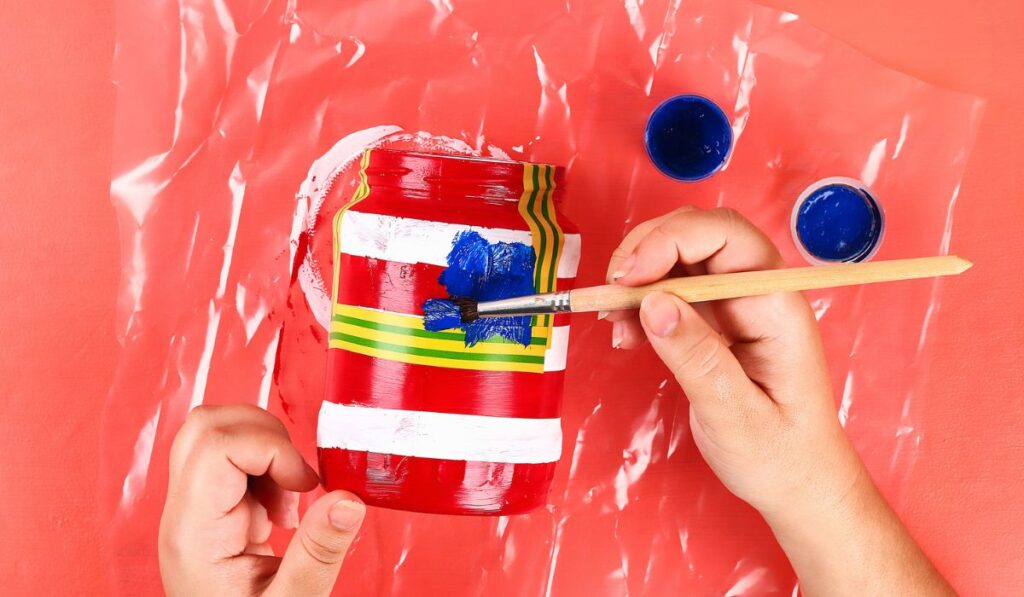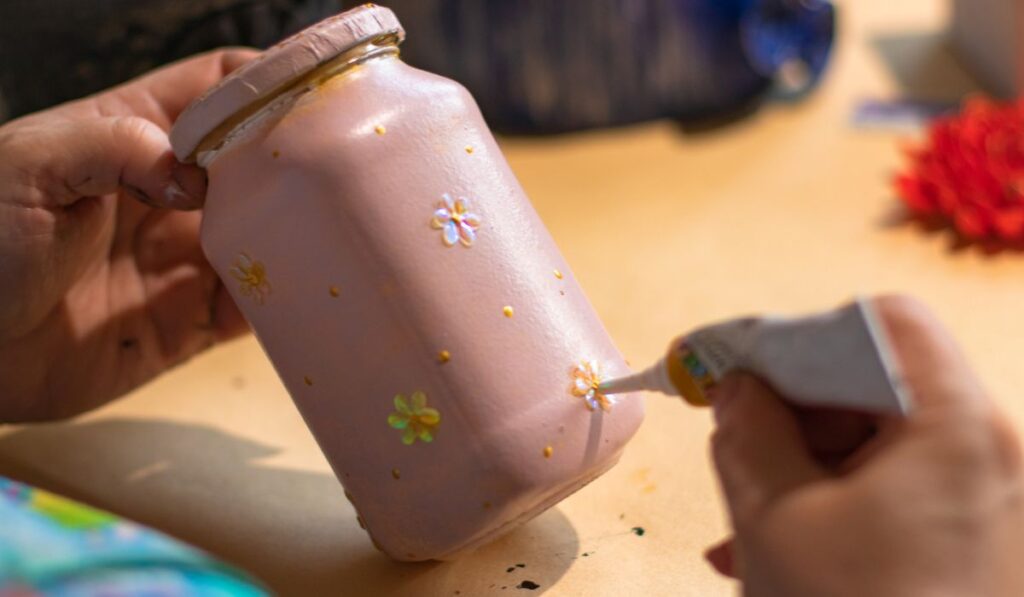Painting on glass is an artistic pursuit that’s versatile, easy to accomplish, and hugely satisfying. With a little imagination, you can give your everyday glassware a unique and beautiful look. But which kind of paint is best to use on glass?
The best paint for glass depends on personal preference and the look you’re trying to achieve. For painting a display window, you’ll need acrylic paints, since they don’t wash out in the rain. For decorative glass painting, enamels might be better. High-quality supplies will give the best results.
You’ll be able to create stunning DIY projects by investing in some glass painting essentials. Let’s look at the supplies you’ll need and how you can seal your paint to enjoy your glass painting for many years to come. We’ll also look at some of the best paints available to help you choose one that’s perfect for you.
Supplies You’ll Need for Glass Painting

Having the right kind of supplies will make your glass painting project more fun, and it’ll help you achieve the result you’re aiming for. Make sure that you have the following items on hand before starting your project:
Glass Paint
There are several options when it comes to paints that will stick to glass; however, most of them have an acrylic base:
Acrylic Glass Paint
This purely acrylic-based paint is quite different from the standard acrylics, which don’t stick to the glass surface. Look for acrylic glass paints that are specially formulated with chemical additives for non-porous surfaces like glass and tiles.
Acrylic Enamel Paint
The name acrylic enamel paint might throw you off, since enamel paint is oil-based and acrylic paint is water-based, but this paint combines the best of both worlds. This paint bonds to a wide range of surfaces, including glass, and solidifies to a hard shell to make sure that the color stays in place.
Solvent-Based Paint
Solvent- or oil-based paints contain high levels of organic compounds, which is why these paints adhere to glass better compared to their traditional water-based counterparts.
Solvent-based paints will give you a highly saturated color; however, it’s best to remember that these paints are highly toxic and more difficult to clean compared to acrylics.
Glass Painting Pens and Markers
Available in a variety of tip sizes and colors, glass painting pens and markers are an easy medium to work with, especially if you’re teaching glass painting to kids. Using these pens and markers also saves you from having to clean the paint brushes once you’re done. You can also use oil-based paint markers for permanent painting on glass.
The type of glass paint you use depends on a number of factors. For instance, markers are best for fine detailing, but they aren’t suitable for surface coverage if you’re painting big objects like vases or glass jars.
Solvent-based paints, on the other hand, offer stunning results but aren’t suitable to use around kids or where there isn’t proper ventilation.
Some Other Glass Painting Essentials
In addition to glass paints, you’ll need:
Applicator Sponges
Sponges can be used to apply paint to the glass. They give your painting a different visual texture, but you’ll also need to use brushes to provide complete coverage.
Paint Brushes
You’ll need to invest in paint brushes that are soft-bristled and pliable, such as watercolor and acrylic brushes. It’s also best to have foam brushes in different sizes and angles for a neat look.
Be bold and experiment with additional applicator tools that are easily found around your home, including cotton balls, toothpicks, and cotton swabs. Make sure to keep latex gloves and a clean microfiber cloth handy to remove the traces of any mistakes that you might make.
How to Choose the Right Paint
Before starting any glass painting, the first thing to consider is the environment where you’ll be painting. Some paints are made to fight the elements, while others may not be able to retain their brightness under certain conditions.
For instance, you’ll need to use acrylic or oil-based paint if you’re painting something that’s going to be outside in the rain. On the other hand, if you’re working indoors, you might like to work with water-based paint to give your painting a more translucent look.
Choosing glass paint that’s just right for you greatly depends on personal preference and the kind of look you want your painting to achieve. If you’re a novice, then it’s best to start with products that are economical and more beginner friendly.
However, if you’ve been dabbling in glass painting for quite some time now, you may opt for products that are designed for the more experienced user.
Best Glass Paints

Choosing the right paint for your glass painting project requires care and due diligence. Having a little knowledge about the products available before buying simplifies the selection process. Let’s take a quick look at some of the quality options that are best for novice glass painters as well as experienced ones:
FolkArt Enamel Glass Painting Set
This set contains 16 2-ounce bottles of beautiful metallic and chromatic colors that are just what you need to get started.
The best thing about these paints is that they’re self-sealing, which means that no additional preparation or sealing is required to make sure that the paint stays on the glass.
These paints are easy to work with and dry quickly. Their strong pigmented finish allows them to retain their bold colors even after drying.
One of the best optiond for beginners, these paints are smooth and fairly scratch-resistant. However, they aren’t meant for use outdoors as they don’t hold too well against the elements.
The FolkArt enamel glass painting set (on Amazon) is water-based, that’s why paintings made with this product will need to be baked in the oven to prevent the color from washing off.
Plaid Gallery Glass Set
This set comes in clear bottles, making it very easy to see the color as well as the amount of paint left in the bottle. Perfect for providing a stained-glass look, this paint dries semi-translucent, which allows light to shine through.
Once dried, this paint looks very beautiful; however, it’s important to note that it’s not highly weather-resistant and may also bubble or chip off in extreme heat. That’s why it may be best to use the Plaid Gallery Glass Set (on Amazon) for indoor projects.
Artistro Acrylic Paint Markers
This set of 12 paint markers is perfect for people who are new to glass painting. These pens dry quickly, which means that there’s no danger of your design getting smeared as you draw. Available in a wide range of colors, these markers have a medium tip that offers users excellent precision and control.
The Artistro acrylic paint markers (on Amazon) are extremely versatile and can be used not only on glass but metal, ceramics, rocks, and even canvas as well. Their color stays vibrant even after drying.
Although they’re durable, it’s best to bake objects painted with these markers before cleaning them in the dishwasher.
Acrylic vs. Enamel
Both acrylic and enamel paints are versatile, durable, and long-lasting. They work great for glass painting, but choosing between the two will depend on the nature of the paint job. However, there are instances when the combination of both these paints will be more suitable. Let’s look at the differences between the options:
Opacity
The primary difference between acrylic and enamel paints is their transparency or opacity. Acrylic paints are transparent, while enamel paints are solidly-colored.
So, for instance, if you want to decorate your coffee mug, then use enamel paints. However, if you’re going for a stained-glass effect on a clear glass window, then it’s best to use acrylic paints.
Flexibility
Another major deciding factor for which paint should be used is how it’ll look once it has dried. Enamel paint dries to a glossy, hard shell, while acrylic paint doesn’t dry out completely, making it more flexible.
Acrylic paint is highly suitable for mirrors and windows, but avoid putting acrylic painted glass in the dishwasher.
Colorfastness

An important consideration when deciding on the type of paint to use is colorfastness. Enamel paints are oil-based. That’s why they may start turning yellow over time.
On the other hand, acrylic paints hold their color permanently, making them the better choice in this regard. This doesn’t mean that enamels aren’t a solid choice when it comes to glass painting; however, it’s best to remember that they may lose their gloss over time.
Prepping Your Glass for Painting
Prepping the glass for painting will ensure an excellent result. In order to make sure that the glass is completely clean and dry, here’s what you need to do:
- Use a mixture of warm water and detergent to wash the glass.
- Next, use a paper towel dipped in vinegar or rubbing alcohol to remove any traces of soap or detergent.
- Let it dry for at least half an hour.
- Use a brush to cover your glass surface with an alcohol-based primer. As these primers are quite runny, make sure that you spread them quickly.
Once the primer is dry, your glass is ready to paint.
Will Paint Wash Off of Glass?
Yes, acrylic paint will wash off of the glass. First, use a piece of cloth and warm water to soften the paint. Now scrape away the paint gently with the help of an old credit card or a putty knife. Take care not to scratch the glass.
How to Seal Your Paint
Once you’ve finished painting your glass, leave it to dry for at least a day or more. Glass paintings made with acrylic paints only need to be set to seal. This may take weeks, but over time the acrylic paint will seal itself.
Other types of paints, however, need heat to seal. An oven is typically used to bake the glass. If your project is a small item like a vase, then this shouldn’t be an issue. But if it’s impossible to fit your object in the oven due to its size, then use a hairdryer instead.
Set your oven at 330 degrees Fahrenheit. Then, put your glass painting in the oven to bake for at least 30 to 45 minutes. Once the jar cools down completely, the paint will be sealed.
